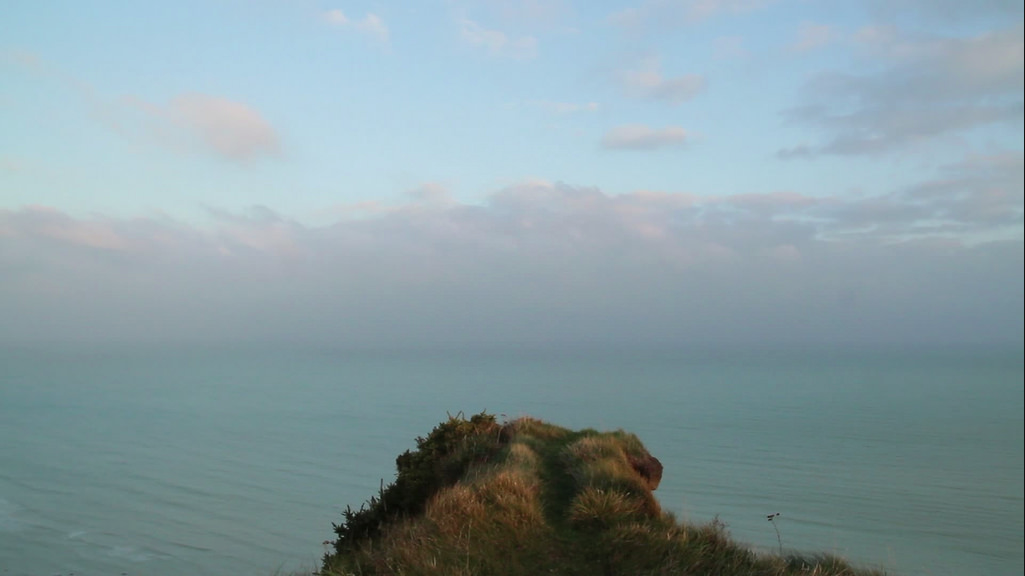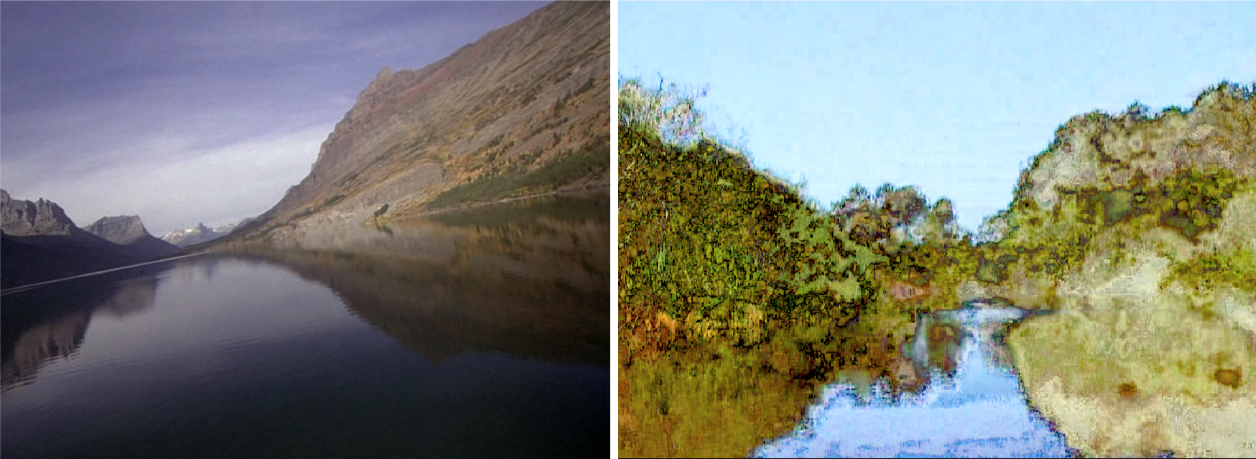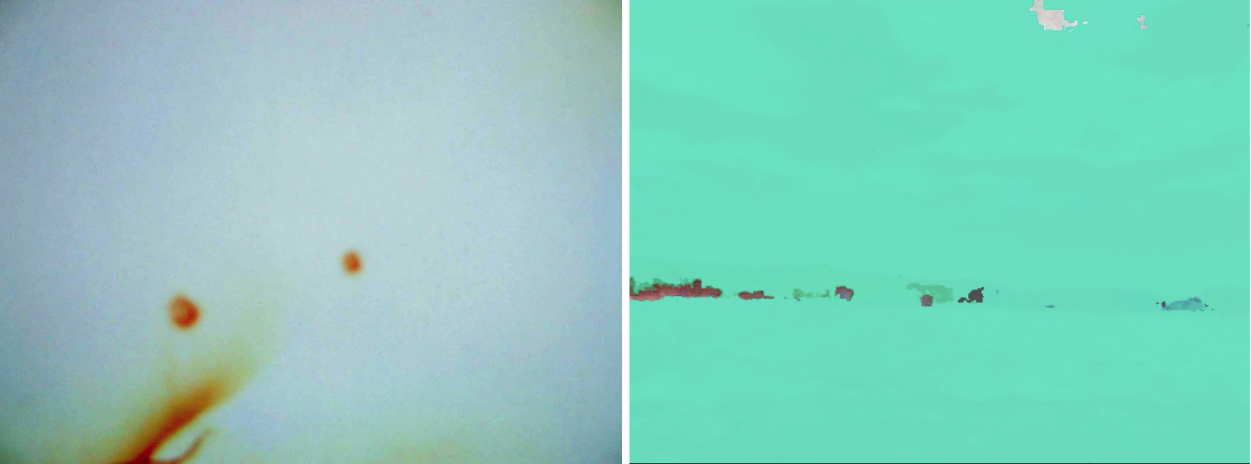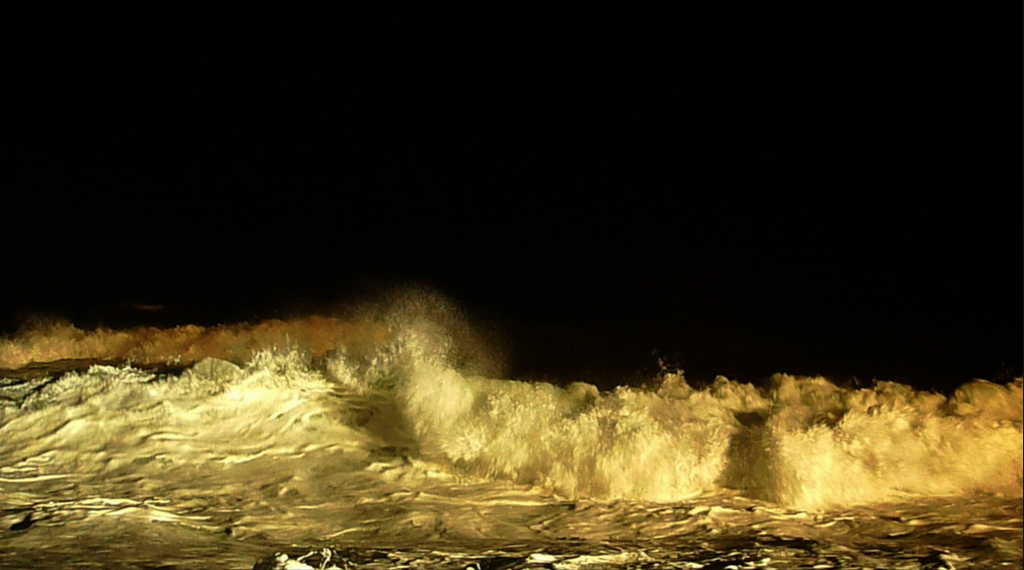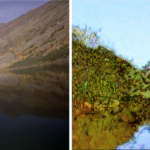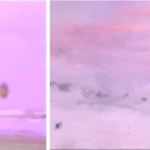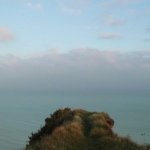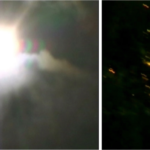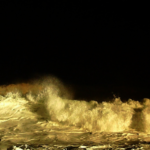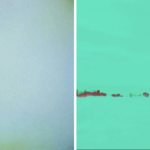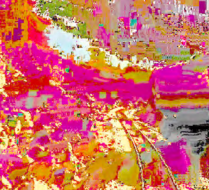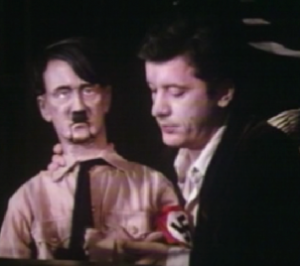Jacques Perconte
Crossings
Last February 6th marked the completion of “Soleils. Retrouver le monde, raconter les images numérique“, a cycle of six programs commissioned by Nicole Brenez and organized by Jacques Perconte and Bidhan Jacobs for the French Cinémathèque. Far from seeking to conclude their creative trajectory with an overlying retrospective view, the film-maker and the theorist have harmoniously interwoven the researches of the former with those of Mike Figgis, Leighton Pierce, Robert Cahen, and Michael Snow. Each program, throughout the course of its projection, created a new artwork through the dialogue of forms, materials, flows and ideas. The screenings thus found a creative dimension that the institution, by usually preferring solemn commemorations, rarely encourages.
The projection as performance: a game just as well played in Time Code with its soundtrack mixed live by Mike Figgis, as in Soleils with its live accompaniment by Jean-Benoît Dunckel. Borrowing its title from Michael Snow’s La Région centrale, the last program presented some of the most beautiful landscape films of Perconte edited together with alternated fragments of Snow’ long film. Snow’s both playful and methodical use of cinematic processes for the exploration of a section of nature (reversed camera position, endlessly rotating movements, etc.) interacted with Perconte’s use of zooms and and travelling shots in such a way that, like the crossing of a crossing, they gave the eye the impression of penetrating the landscape by running aground the eruptive surface of the digital image. Though different, these two aesthetics converged in their same desire to depart from the humanist-perspectival position of the camera towards nature. The beauty of the program, a true technical feat, was also realized by alternating 16mm and digital film. Every juncture was vertiginous and pleasureful, a true moving experience that, by mixing light and affect, culminated in the long embrace of the two superimposed shots. That night, we had the impression, with rare intensity, that the projection could be a true cinematic event.
The next morning, Jacques Perconte and I were sitting in his studio, in front of his computer screens and innumerable external hard-drives. While discussing the cycle of screenings, our conversation quickly became a journey through his oeuvre, with films and documents being summoned with just the click of a mouse. The filmmaker makes most of his videos available on his website, a sign of his generosity and desire to make the creating and sharing of his work one seamless experience.
Débordements : What was your artistic and scientific training?
Jacques Perconte : I started drawing when I was very young. It was the means of compensation that I developed to express my emotions. My mother always encouraged me to pursue the fine arts. She enrolled me in an evening course in high-school. I was pretty good at maths, but nonetheless inclined towards the humanities. I made some short fiction films with my friends. I also wrote a lot. When I applied to the Ecole des Beaux-Arts in Bordeaux, after having passed the first, portfolio-based phase of the exam, I encountered the brutality of attitudes that I did not understand. After being refused, I went to study visual arts at the university. There, we were told over and over (we were more than 200 students in our first year) that we would never become artists and that we didn’t have anything better to than to just work really hard in order to get a position as teacher somewhere… The first year was very demoralizing. There were a lot of very dull courses. Confronted with the a priori idea that painting and drawing were not directions that one could take, I decided to look for another way into art. I then began to work with video and computer graphics. People were talking about video as art, while computer graphics was considered as a technique and a profession: a domain waiting to be explored. It seemed like few works using video and computer graphics had a real artistic dimension, and therefore I decided to further explore. I began to search for what could happen in an area between video and computer graphics.
I don’t really have a scientific education. I spent a few years in a CNRS research center, first as an intern while still being an art student, and then as a conscientious objector….These four years, I believe, were the most formative that I have experienced up to now. It was my fresh knowledge of the internet that brought me there. It was in archeology that I truly came to know computer science. Robert Vergnieux, who directed the platform Archéovision, really taught us a lot.
D. : Does scientific research continue to interest you?
J.P. : Of course, but I do not know how to explain or express this interest. We shall know more once I finish the project I have started on the ties between art and nature. One of the strings that I am plucking in my work right now is the “lyrical thinking” [pensée lyrique] by Roger Caillois.
What I can say about this project for now, is that the exchanges that are taking place today with several researchers in the humanities are very valuable.I would like to mention in particular Bidhan Jacobs. He has developed an interpretation of my work that has shed light on certain forms that have enriched and liberated my view on my own practice. The most apparent example is the place that he has given to a small piece I entitled Le soleil de Patiras (2007). I had simply put aside a sequence from a filming session around the island of Patiras, since I loved some elements of it. When Bidhan focused on the piece, he immediately saw “how in it [I] elevated the detection of the signal [signal] of the industrial device (a mini-DV Sony DCR-PC 120 E) to the level of human perception in such a way that [I] brought to the surface of the image the deep structures of reality.” In this way, he liberated me from the necessity to push even further the plastic work on the image, when I don’t really want to do it, and when it is not really necessary. I therefore considered this small piece as a film, and I made space for some sequences of this kind in my films.This is what allowed me to create Chuva (2012), which begins with a long sequence of falling rain taken with a fixed shot, and in which we reach the perceptual limits of the camera in order to then slide into abstraction and into the dynamics of compression. This is what really directed me towards this documentary sliding that is taking place in my current research.
D. : What were your first experiments with film?
J.P. : I began with fiction during high-school. I needed to go quite far in this direction before I could realize that I was really trying to experiment. I made various short films such as Azar (1995), for example, which were often closer to visual art than to commercial cinema. I also made a medium-length film entitled Sables (1997), which was also relatively abstract. My attitude towards fiction is not very typical. I don’t try to tell a story according to a specific genre, even though there may be characters that relate to the story. Then I began a project for a feature-length film entitled Chloé (1999) with the support of Jan Kounen, whom I was very close to in the late 1990s. It was very scripted, with a rather large team and often a lot of extras. The film was shot digitally. I really wanted to question fiction from the vantage point of video. My experience in the visual arts had helped me understand the importance of the medium and the relationship between the technique that was employed and the story. I even wrote a script for a fiction film, Chi Ocsha (2000), that did not even become a film, but was transformed into electronic literature and into a performance, evoking the passages between analog and digital film.
Chloé worked, within the closed, cellular space of a couple, on a certain relationship toward fantasy and murder. There were three different couples, each played by the same actors. The idea was to work on composite images, with some inserts producing moments of interaction and points of tension within the frame. The film was shot, but Jan Kounen distanced himself from the project once he understood what I was really trying to do. The post-production was not completed – neither with Jan nor with the other two producers I had found. The shooting took place between the end of 1998 and the beginning of 1999. It was then technically and financially very complicated to produce such images. Nowadays, you can make them by yourself. Chloé therefore remained at the stage of rushes and post-production plans.
It was precisely this experience that allowed me to understand that my interests were far from the standards of cinema, even if my current work is also greatly influenced by my love for the most “classic” cinema. There has been a sort of late convergence between my cinephilia and my artistic work with moving images, but at the base there is my passion for the films of David Lynch, John Ford, or Sergio Leone. I also grew up watching horror films, even though my relationship to the representation of violence has greatly evolved since then. I do not watch anything bloody anymore.
D. : After watching Après le feu (2010) on the big screen, and even more so Àrvore Da Vida (2013), in which the music seemed similar to that of György Ligeti, I thought for the first time about Stanley Kubrick films, in particular, obviously, the “journey” through space in 2001.
J.P. : I discovered 2001 rather late, as I was already studying the visual arts at the university. I avoided it for a long time. It intimidated me a bit. What is curious is that, even though I found the visual effects extraordinary, I did not try to know who was responsible for such effects. Nowadays, I can no longer watch 2001 without thinking of John Whitney’s films. But for me, Kubrick is not the most important director in terms of the image. David Lynch was more influential in this aspect. I discovered him through the series Twin Peaks. His films had a strange relationship to time: a form of suspension one would say. Another turning point for me was Crash by David Cronenberg. It was the first time that I had seen a movie theatre empty out so quickly. Sombre, by Philippe Grandrieux, was also extremely important for me. I really understood that what happens in film, seen within a movie theater, can be art, and that cinema is a very powerful medium.
And then there was Bill Viola. One of his films, The Passing, was presented in Lucarne, a series of broadcasts shown on the tv channel Arte dedicated to experimental cinema and artists’ video. One must also underline the role of television, which truly opened up new horizons. I don’t know if it’s still the case. I then discovered Chott El-djerid, without a doubt my favourite of his pieces. In seeing its light vibrations something became clear to me. For the first time, I truly saw the technical expression of an image. It was because the light was filmed in such a manner and with such a peculiar use of optics that the image seemed to explode – in other words, the image became plastic. Another huge discovery was Stan Brakhage, who arrived on the scene even later in my life, at the time of my move to Paris. I had already made some films.
My transition to experimental cinema also came out of an increasingly stronger disappointment I was feeling towards the movies that I could see at the movie theatre. I learned how to make films by analysing in extreme detail the ones made by others. For instance, during my last year of highschool, I re-wrote Interiors by Woody Allen. I broke up the film shot by shot in an attempt to understand its staging. For each shot I had various pages of notes in which I documented every detail – from the dialogues to the movements of the camera. I did this for five to ten films. Cinema was truly a devouring passion of mine. Then, all of a sudden, I started feeling less pleasure. This stage of adolescent cinephilia was coming to a close. I progressively came to realize that this disinterest was caused by the images, and by cinema’s incapacity of fully embracing its technical determinations. I also started guessing the endings of the movies while I was seeing them. I felt as if the filmmakers anticipated the turn-out of the plot in every scene.
By beginning with shooting fiction films, I understood that I needed to have a very direct relationship with what I was doing. In fact, I realized that the things I was making needed to be in a constant state of evolution. For Chloé, I had a very elaborate script. However, when the time came to start filming, I re-wrote the film day-by-day. The story changed gradually. Nevertheless, amateur cinema is still based on the model of commercial cinema, with a large film crew. It is a very difficult machine to maneuver, one that often implies a difficult and painful “management” of relationships. There also huge constraints when it comes to grants. My project Chi Ocsha, which was presented in an Italian-style format, was all written from the point of view of the main character. It was not given any financial support, because it did not conform to the procedure. It was after these two unsuccessful experiences that I decided to move on and follow a more solitary path. This decision was a real break, as I had just created, together with Fabriche Marache and Jérôme Meynardie and around the Chloé project, an association called Paradoxal, which organized a festival and produced films. I decided to quit the association during this period. Nowadays, Fabrice still produces and directs documentaries, notably his film Iranien. He runs the Atelier Documentaire, a production coop company. Jérôme remained loyal to fiction and independent cinema.
D. : What was your first response to this breaking away from fiction?
J. P. : A film named Promenade, which was filmed in a short time in 1999. It was about three walks (hence the title Promenade), with three actresses: Laeticia, who acted in Chloé, Karen, whom I had envisioned for the role of Artémisia in Chi Ocsha, and Anne-Sophie, a friend who would later pose for me, since at that time I was taking a lot of photographs. The visual arts always occupied a parallel dimension to that of cinema. There were not yet any overlaps. The film was presented in two or three festivals dedicated to television since my producer was part of that world. In this context, whether at Sarlat or elsewhere, it was a complete UFO. It was very weird.
Promenade is composed of three walks engaging different visual effects. The first one employs as a technique the animation of photographs that are overlayed onto paintings through digital means. The second was made by re-filming videos on a screen, with a powerful play on textures and moiré patterns in order to obtain a dissolving of form. The last walk works on the blur. It was filmed out of focus on mini-DV, and then I re-filmed the result by projecting the image.
D. : You worked a lot on re-filming and the accumulation of layers of material at the time.
J.P. : Yes, enormously so. There were two stages in my artistic approach : filming the screen, and then seeing what resulted in the image. This was my itinerary, which has always been characterized by an approach to the image plasticity. I worked with scanners, for instance. I would pour some liquids and I would then press my hands, arms, and head, striking the machine. One could see emerging the traces of the scanner’s movements [see gun in the hand, scanner in the head (1996)]. I would also re-scan the images I had already produced. Once again, it was a way of accumulating material and of producing disturbances. These researches may date back to an assignment at my university on the subject “the body of the line, the line of the body.” Pierre Garcia[11][11] Author of Métier du peintre, published by Dessain et Tolra. led this workshop. He allowed me to move forward with my ideas without having to consider any distinction in terms of discipline (drawing / painting). I had produced about thirty drawings of women from live models. It was an experience of hard work that made me understand the importance of mark. I knew how to draw “well”, but what I produced was flat and boring because I did not really engage any gestural quality.
When I started working with machines, I looked for ways of printing a physical trace on a piece. I twisted cables, cut them, and ultimately broke into the machine in order to find a way of manipulating matter through gestures.
From my studies of “the digital bodies”, such a ncorps (1998), I started to develop tools to produce images that contained the expression of their own material base, that is to say images in which the technologies used to transfer and record them manifest themselves on the surface. The “Digital Bodies” are a collection of pieces, a research project. At the beginning, they were founded upon the concepts of “movement-image” and “time-image” elaborated by Gilles Deleuze, transposing them towards the digital realm. Quickly, the issue became related to the images’ historicity, the traces left by the different media through which images circulate. How can an image tell us of its journey through the technological media? I wanted to understand the path of light: from when it reflects off a body, to when it is captured by a camera or any other digital photographic device, shown on a television screen, organized into a digital animation, uploaded onto the internet, downloaded through a browser, captured once again by a new camera, and then shown on another television screen… I analysed all the traces that were recorded in the image’s body by its history. I went about these researches very scientifically, surely because I had been a very young member of a research team. I then had the idea of crossing this research with fiction, notably through the characters that I had invented for Chloé. Little by little, there came to be a convergence between filming, staging, and working on the plasticity of the images. One can see this process in a dance piece called Phex (2001). At the time, I still used to film a lot of screens. Then, however, rather than focusing on the image, I decided to focus on the screen of the cathode ray tube TV itself. I was interested in what was happening between the surface of the glass and the image, in the textural vibrations, in the image structure. I also discovered something that I had never seen before and that attracted me. My computer was not powerful enough at the time to deal with all the information it was handling, so it made me compress the video files. The “defects” that resulted from this compression looked so beautiful to me. The entire second half of Phex hence became a composite of such compressed videos. For the ending I compressed, compressed, and re-compressed multiple-exposure and slow-motions images for a total of ten times, until all that appeared was a very high saturation level in the whites and the colours of the image, showing some extremely sensitive internal structures. In discovering these visual effects that are specific to the digital medium, I decided that it was a path worth pursuing. Phex therefore became a way of entering within the image.
Wisz (2002) was another way of approaching this question. At the time I used to do a bit of VJing. I had to perform in Bordeaux with Kid 606, an American DJ that was quite hardcore. I prepared a live performance consisting entirely of red and white compressed videos. Starting from a 3D model of a form twisted in every way, I proceeded to work with a series of compressions until the form would disappear, becoming unrecognizable.
D. : Does one have to use specific software in order to work with video compression?
J.P. : Video compression is a very basic digital technique. At the time, computers were not powerful enough to process raw images. They were simply struggling. To reduce the amount of information needed to read an image, one had to reduce the size of the file through some kind of compression. In all video compression software, there are exporting functions that allow you to export the video into other formats, in order to view it or to circulate it on the internet. Compression causes very important changes in the internal organization of the video file. What begins to appear are the traces of the mathematical operations that are used in order to save memory space and reduce information. I discovered through this process the variations of colours and the expressive force of the chromatic deformations. By studying the results of these changes of parameters, I begin to create a language that allows me to alter the digital structure of the files. For instance, I might open the video file with a text-editing program to see how the compression was generated.
D. : Did you modify the code directly?
J.P. : Yes, a bit, but this was not my favourite way of working. I never wanted to master the process by programming it. I have always been more attracted by bricolage. What interests me is to divert, to discover, which is why I choose to crush and “break” my videos in quite a brutal fashion… The problem is that after I “break” a video, I need to be able to view it. I understood thereafter that temporal compression is a question of blocks. When the video is compressed, the file is cut by the software into blocks that have structures constructed around a key-image. These key images are a kind of punctuation : key-image, no key-image, key-image, etc. They are sort of “tags” that redefine the way in which a block of images functions until the next “tagged’ block appears. When you omit one of these key-images, you remain on the one that precedes it. There is hence a sort of graft that fills in the blank between the two tags, which produces a transformation of the first. The images are mixed, which is a process that happens in time – it is no longer simply random. I came upon this process towards the end of 2001 – early 2002.
D. : Do you continue to work on this purely abstract material after Wisz?
J.P. : I worked on some 3D pieces, in relation to some questions on architecture for instance, but I quickly broke off from this path since I care about the model as well. I took a lot of photographs in which the body was essential, as well as the relation between the textures of the skin, the screen, and the compressed image. In XSZ (2002), I compress film images placed on a black background from which I then make a composite of normal images that appear hence sharply cut-out thanks to this heightened contrast. In SNSZ (2002), a pornographic film tending towards abstraction, the body becomes the driving factor of the internal movements of the image. I filmed the bodies, but all that can be seen are the artefacts produced by the digital manipulations. This film is my last work on the body. I had the impression of having arrived where I had wished to go. I had discovered the power of a new technique, and now I needed to make it work better. The body was not the motif that could lead me further.
D. : From this moment on, you began your research on landscape.
J.P. : Yes. I felt like I had found a personal technique that could truly become my personal medium for expression. I hence wanted to re-inscribe myself in a general history of art, and focus on one motif, the landscape, which was of huge importance to artists like Turner and Monet who contributed to the revolution that took place in 19th century painting. Uaoen (2003), my first film on this subject, aims at the disappearance of the symbolic dimension of the image, that is to say, in this case, the disappearance of perspective. Little by little, the process became about entering the physical reality of the image through a manipulation of the horizontal and vertical movements. The digital image is a flat plane of physical points. We call these points pixels. They do not move but rather are triggered and lit up according to the message they receive. The rhythm of these variations in brightness (luminosity-color) within the whole matrix gives in time an impression of movement.
In fact, these perceived movements are either vertical or horizontal. Working on video compression makes these movements visible: when cut into blocks that are moving on a grid, the image reveals its natural fluidity, its mathematical architecture (the square blocks that move on the flat grid either horizontally or vertically). The image is as a result no longer an object to be read from one fixed perspective, within a symbolic perspective. The possibilities of interpretation are then multiplied, both from a cultural and from a material viewpoint.
I have a physical relationship with nature, and a political one with the landscape. When I film, I set up my frame, but after that I do not look through the lens. I stand next to the camera. I discover what I filmed only when I return home. Everything takes place at the moment of framing. I record rather important portions of time, and then pick the ones in which something happens : the wind that blows and makes the camera vibrate, a bird that flies by, or the rain that begins to fall. The visual expression is very much linked to the material, to what happens in front of the camera and over which I have no control, even though I look for it as I film. Framing, lighting, and composition are all essential elements. Afterwards, when I begin working on the computer, I have a memory of what the image was, but the challenge is to reveal something else in the shot, something that does not refer to the original image. I work on the internal movements of the shot – the birds flying by, the smoke, the dust, the vibration of the light, etc.
I always use big lenses. In my latest film on Scotland, for instance, the image vibrates enormously. One feels the wind. One feels as if the cliffs were flattened and interweaving. This is what creates a link with the image fabric that appears due to the compression. I do not try to make the viewer believe that he/she is facing a landscape. The simulacrum is presented as it is. And yet, nature is intensely present as it becomes completely detached from its own image. What we see is the result a technical operation that allows me to preserve an imprint of nature, rather than its analogical “transparent” double. Because nature is not in the image. In fact, I narrate a visual, plastic history, a history of the relationship that I have with the moving image of a landscape. I stage my own relationship to the degradation of the image on the screen, to the particularity of its colorimetry, etc.
D. : Is the data manipulation applied in precise areas?
J.P. : No, it is applied onto the entire image. It therefore depends on its composition. For instance, Impressions (2012) relied entirely on the fact that it was filmed with a fixed shot. This choice surprised my producers, because my whole technique is centered on movement. Whether my camera moves or not, the world never stops changing, even if ever so slightly. After having filmed for a long time and having used a telephoto lens, you can capture the vibrations produced by the different densities of the air and by the light. The road or the railway are therefore also in movement. This is what my work tries to reveal.
The material and visual potential is always a result of what is being filmed. The technique allows me to make this potential visible. I don’t really like being the one who composes the movements that occur inside the image. I find pleasure in the fact that a small glitch can make something appear – a bit of red or a bit of blue that begins to wander around the shot thanks to the vibrations of the image. In this process something magical happens. My job is to stabilize this glitch, to record it, or to seize some particular vibration which will in the end reveal something through some kind of compression. Nature is no longer there. It persists and it is represented, but is no longer there.
D. : How do you work with sound?
J.P. : The sound depends on the evolution of my material. This goes for the image as well. I have many different cameras, from a pro Sony camera to a small pocket device, to even my cell phone. My next film will be made in a train using a cell phone. The sound of Uishet (2007) was captured by a 90 euro Sony microphone and saved on a mini-disc. Nowadays, I have a Nagra and some higher quality microphones. When it comes to direct sound, I respect its fabric. I would never, for instance, use a sound from Normandy on an image of Scotland. I have a very strong respect for the location’s ontology. I tell the relationship that I have with the material I have recorded, as well as the place that I am filming. I try to be honest from this point of view. There is a relationship with a lived experience.
I love putting music in my films. I sometimes compose it myself. For my film on Scotland I will be using a mix of musique concrete and drone music. However, I never include music in my installations. I like using music because I make cinema in the same manner. It is a way for me to surround the spectator. Music embraces. When I start a film I often, for some reason, think of the name of a musician. It is as if, deep down, every film were already potentially a piece of music. Most of the time it is the musician that makes the music. A music that I don’t want mimicking the image, one that I like to be free, to be at ease. A music that allows me to escape the film’s rhythm from time to time and then return to it in other moments. I often change the style of music even though I do have certain preferences. I love working with Samuel André, Jean-Benoît Dunckel, or Simonluca Laitempergher.
D. : What are your current projects?
J.P. : I have just finished my Scottish film, Ettrick, which will be presented in the Festival Côté Court this July 2015. It is the result of a long-term adventure[22][22] Shooting documents are available in a rich photographic album. that started after Pip Chodorov presented Uishet at the Alchemy Film Festival in Hawick four years ago. Richard Ashrowan, its director, discovered then my work. He invited the next year me to show Impressions. I was very happy to be given this opportunity to go to a country I did not know. The festival is extraordinary, because of its program, the filmmakers that are invited – some of whom, such as Robert Cahen, Chris Meigh-Andrews, Enrique Ramirez, Michel et Patrick Bokanowski, Joost Rekveld ou John Woodmann, became my friends -, and the projections in the natural landscape.
The light in this month of October also made me want to explore more. Despite the weather, the tall grasses in the valleys were colored with wonderful nuances of yellow and greens. I began to wander around, and I filmed a few rugby matches. The whole experience really made me we want to go back. A few months later, I started filming without really knowing what I wanted. Little by little, I discovered the depth of an environment modeled by human activity. I found out that the wool that was being used in the textile industry was not coming from the sheep that we were seeing everywhere. Another surprise was that the Ettrick forest, which I have been told is larger than the city of London, is being destroyed and then replanted plot by plot because it is subject to an intense exploitation. The path through the forest (which cannot be publicly visited because it is privately owned) is a path through massive trees, pressed together like sardines through which the rays of the sun barely filter, whereas in the exploited sections of the forest all that is left are a few trunks amid uprooted stumps to avoid birds deserting the area. The journey is very rainy, windy, foggy and cold, but it has incredible scenes to offer. The third journey takes place again during the festival. I passed a lot of time on the roads exploring the “Borders”, a lawless region between England and Scotland. It was on this trip that I understood that it was essential to include the issue textiles in the project. It was by looking through the car window at the unfolding landscape and the mixing colors that I remembered the textures of the wools and of the cashmeres weaving together the roses and the greens, the browns and the reds.
Since I was at the heart of the Tweed region, I had the idea of injecting some element of Scottish culture in the landscape, using tartans as a means that unleashed its plasticity within the images of the forest. After that I decided to film the textiles as they were been produced. Landscapes, textiles, machines, and forest exploitation started to come together. In a certain way, a documentary dimension started to appear in my work, without me trying to explain and narrate the story of a social space. I glue things together in such a way that it makes them interact with each other. It is an aspect that appeared softly in my work, notably in the film M (Madeira). It will also be the starting point of my next project. It is a double project. A film on Iceland and its volcanoes in which I will use the music of Starwalker (Jean-Benoît Dunckel et Barði Jóhannsson), as well as a transmedia documentary essay on exploration of this issue of landscape through the relationship between art, man, and nature. This is all I can say for the time being.
And, since one never works alone, I would like to take this opportunity to thank my partner, Isabelle Silvagnoli, who accompanies me and supports me in my projects, as well as my producers: past (Triptyque films, Guillaume Massart and Thomas Jenkoe in particular), present (Rodolphe Olcèse with Too Many Cowboys, whose support and friendship are precious), and future (Darjeeling, with whom a beautiful adventure is about to begin). I would also like to thank, sincerely, Bidhan Jacobs and Nicole Brenez.
You can follow Jacques Perconte's work here : http://timeline.technart.fr/ , http://www.jacquesperconte.com and http://www.galeriecharlot.com/fr/5/Jacques-Perconte
Except as otherwise provided herein, the images are coming from Jacques Perconte's films : Sassetot-Le-Mauconduit (2012) / Shining (Stanley Kubrick, 1980) and Uishet (Sans titre n° 5) (2007) / Chott El-djerid (Bill Viola, 1980) and Impressions (2012) / Sarasvaati (2001) and Annette (2009) / Promenades (1999) and Le Soleil de Patiras (2007) / Impressions.
Translated from french by Lorenzo Somaini.
